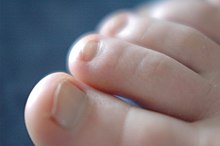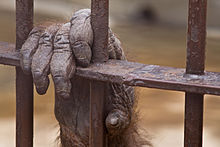User:Korkemxx/Ногти



Nails are Horny plates (homolog claws) on the rear surface of the ends of the fingers of the upper and lower extremities of most primates. Nails are derived from the epidermis.
Oncology — official science that diagnoses the condition of the nails.
The structure of the nail
[edit]The front edge of the nail plate is free, the back and side edges are surrounded by a skin fold. The upper part of the skin fold is approaching the nail plate and is called the proximal roller (cuticle), which performs a protective role, preventing foreign bodies and bacteria to penetrate to the germ zone of the nail. The edge of the roller is keratinized cells. Drying out and then exfoliating, this edge gives rise to burrs.
Distinguish between the body and the root of the nail. The root of the nail is called the back of the nail plate under the proximal nail roller. Only a small part of the nail root protrudes from under the nail roller in the form of a whitish area of the semilunar shape (nail hole).
The root of the nail lies on the back of the nail bed and is called matrix. Matrix — the place of formation of the nail plate; it consists of epithelial cells. In the spinous layer of these cells is oligoblastic — the cells forming the nail, which turns into Horny plates of the nail.
The basis of the nail plate — keratin — protein present in the skin. From him same are formed hair. The density of keratin in nails and hair is due to the fact that this protein contains a significant amount of sulfur atoms. The bonds formed between the molecules strengthen the protein, making it hard. In many ways, the amount of sulfur (or rather, cysteine, amino acids, which includes sulfur) is determined not only by its content in the body, but also hereditary characteristics. So, some people have a higher concentration of cysteine, which makes the nails hard.
Between the layers of keratin are thin layers of fat and water. It is these layers that give the nail plate elasticity and Shine. Nail can absorb water, while increasing its thickness. Therefore, people who are often in contact with water, nails become soft and thick.
In addition to sulfur in a healthy nail contains other trace elements — calcium, chromium, phosphorus, selenium and zinc. Their absence makes the nail sick.
Nail growth
[edit]Nails grow slower than hair. In an average week, the fingernails grow to 1-2 mm, and the nails of the feet — 0.25—1 mm. Complete upgrade of the nail occurs on average once in six months. Hormonal changes (adolescence, period before menstruation, pregnancy, in the spring) can affect the speed of nail growth, as well as activities leading to nail grinding (typing, habit of constantly biting nails, hand massage, etc.). Slows the growth of the nails overly strict diet (low in fat, protein, vitamins) and diseases involving blood circulation and metabolism. The nail plate is normal (smooth, smooth, pink slightly shiny color) has a thickness of 0.3 mm.
Nail hygiene
[edit]Nails — a good indicator of the health of the body: their condition directly indicates a deficiency of certain substances. thumb|Nail clipper
Interesting fact
[edit]- Nails grow faster: in men than in women in summer than in winter on the working hand
See. also
[edit]- Leukonychia — white spots, stripes on the plates of nails Onihofagiya — obsessive biting nails Onychocryptosis — ingrown nail Onychomycosis — nail fungus Onihodistrofiya — nail dystrophy Symptom of watch glasses Manicure Nail art
Notes
[edit]Literature
[edit]- Knipovich N. M., (1890-1907). Nails, claws, and hooves. Brockhaus and Efron Encyclopedic Dictionary: In 86 Volumes (82 Volumes and 4 Additional Volumes). St. Petersburg.CS1 maint: Multiple names: authors list (link) Demin R. N. Ancient Chinese philosophy on nails (drawings on nails as a means of mnemosine) // Philosophy — Children. Intellect and creativity: Proceedings of the Fifth International scientific-practical conference .6-8 November 2012, Moscow, 2012. — P. 12-14.
[[Category:Body art]] [[Category:Integumentary system]]
